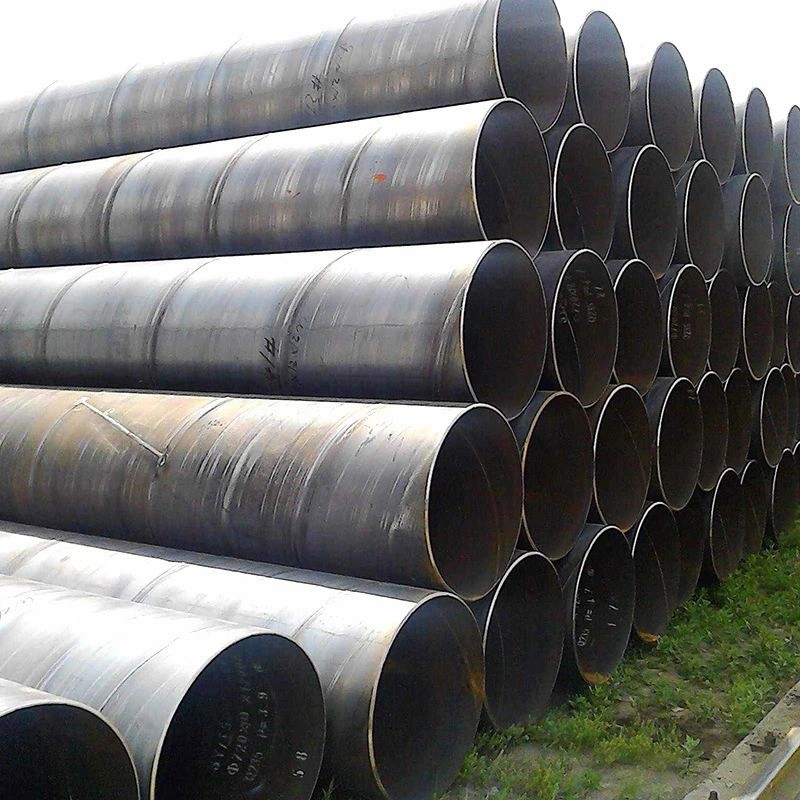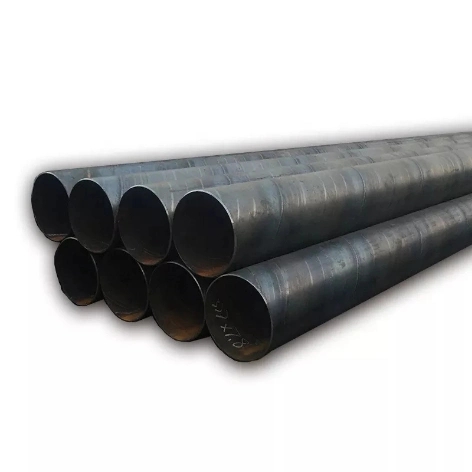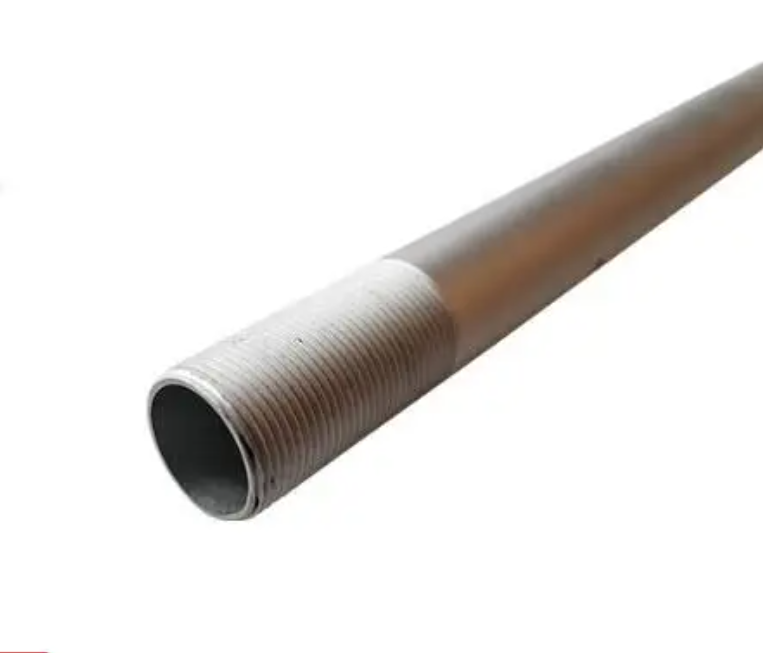- All
- Product Name
- Product Keyword
- Product Model
- Product Summary
- Product Description
- Multi Field Search
Views: 0 Author: Site Editor Publish Time: 2025-10-22 Origin: Site









Choosing the right pipe connection method can be crucial. Welded pipes offer strength, while threaded pipes provide flexibility. But which suits your needs best? This article explores these options. You'll learn the importance of selecting the right pipe type and compare welded and threaded pipes. Let's dive into the details!

A welded pipe is a type of steel pipe formed by joining metal edges through welding processes. Unlike seamless pipes, welded pipes have a visible seam where the metal is fused. Common types include ERW pipe (Electric Resistance Welded), spiral welded pipe, and LSAW pipe (Longitudinal Submerged Arc Welded). These pipes are widely used in various industries due to their strength and versatility.Welded steel pipe can be manufactured in different shapes and sizes, with the weld seam running either longitudinally or spirally. The welding process involves heating and fusing the pipe edges to form a continuous joint, which provides a strong bond. For example, stainless steel welded pipe offers excellent corrosion resistance, making it suitable for harsh environments.
Strength and Durability: Welded pipes provide robust connections with high structural integrity, especially when proper welding techniques are applied. The continuous weld seam minimizes weak points, making them ideal for high-pressure and high-temperature applications.
Cost-Effective Production: Compared to seamless pipes, welded pipes are generally more affordable to produce, especially for larger diameters.
Versatility: They can be produced in various sizes and thicknesses, accommodating different project requirements.
Smooth Internal Surface: This reduces turbulence and pressure loss, beneficial in fluid transport systems.
Material Options: Welded pipes can be manufactured from carbon steel, stainless steel, and alloy steels, allowing compatibility with diverse operational environments.
Weld Seam Vulnerability: The welded seam can be a potential weak point if not executed correctly, requiring skilled labor and quality control.
Corrosion Risk: Without proper treatment, the weld area may be more susceptible to corrosion compared to seamless pipes.
Less Flexibility: Once welded, pipes are permanently joined, making modifications or repairs more complex.
Installation Complexity: Welding pipe to pipe demands specialized equipment and experienced welders, which can increase installation time and costs.
Welded pipes are extensively used in:
Oil and gas pipelines, where strength and leak resistance are critical.
Water and sewage transport systems.
Structural applications in construction and infrastructure.
Industrial process piping requiring high-pressure resistance.
LPG station design and other hazardous fluid transport systems.
Welded pipes are compatible with:
Carbon Steel: Most common, used for general applications.
Stainless Steel Welded Pipe: Preferred for corrosion resistance in chemical and food industries.
Alloy Steels: Used in high-temperature or high-strength scenarios.
ERW and LSAW Pipes: Selected based on diameter and pressure requirements.
Choosing the appropriate material ensures the welded pipe meets environmental and operational demands, enhancing durability and safety.
Tip: When selecting welded pipes, always verify the welding quality and material grade to ensure optimal performance and longevity in your specific application.

Threaded pipes connect by screwing the pipe ends together using matching threads. The threads are typically tapered (such as NPT - National Pipe Tapered threads) to create a tight seal when fully tightened. This mechanical interlocking allows for easy assembly and disassembly without specialized equipment. Threaded pipes are often made from carbon steel, stainless steel, brass, or PVC, and are common in smaller diameter piping systems.Unlike welded pipes, threaded pipes do not involve fusing metal but rely on the precision of the threads and a sealing compound or tape to prevent leaks. This connection type is popular for plumbing, low-pressure fluid transport, and systems requiring frequent maintenance.
Ease of Installation: Threaded pipes are straightforward to assemble without the need for welding equipment or highly skilled labor. This makes them ideal for quick installations or repairs.
Flexibility: They can be disassembled and reassembled easily, allowing modifications or maintenance without cutting or welding.
Cost-Effective: Threaded pipes generally have lower upfront installation costs since no welding labor or equipment is required.
Suitable for Low-Pressure Systems: They perform well in residential plumbing, compressed air lines, and other applications where pressures and temperatures are moderate.
Wide Material Compatibility: Threaded connections are available in various materials, including stainless steel welded pipe, carbon steel, and non-metallic options.
Leak Potential: The seal depends on thread integrity and sealing compounds, which can degrade over time or if installed improperly, leading to leaks.
Reduced Strength: Threads cut into the pipe reduce wall thickness, creating stress concentration points that may weaken the pipe, especially under high pressure.
Not Ideal for High-Pressure or High-Temperature Applications: Threaded pipes are less durable in demanding environments where welded pipes excel.
Thread Damage Risk: Threads can be damaged during handling or installation, compromising the connection.
Size Limitations: Threaded pipes are typically used for smaller diameters; larger pipes are generally welded.
Threaded pipes are commonly used in:
Residential and commercial plumbing systems.
Low-pressure compressed air and gas lines.
Temporary or portable piping setups.
Low-pressure industrial piping.
LPG station piping at distribution points where pressures are moderate, and ease of maintenance is valued.
Threaded pipes are compatible with:
Carbon Steel: Widely used for general-purpose applications.
Stainless Steel Welded Pipe: Available with threaded ends for corrosion resistance in certain applications.
Brass and Copper: Common in plumbing for water and gas.
PVC and Other Plastics: Used in non-metallic piping systems.
Material selection should consider the fluid type, pressure, temperature, and environmental factors to ensure safety and longevity.
Note: When using threaded pipes, always apply the correct sealing compounds and avoid over-tightening to prevent leaks and thread damage.
When it comes to strength, welded pipes clearly have the edge. The fusion process used in welding creates a continuous joint, providing superior structural integrity. This makes welded steel pipe, such as ERW pipe, spiral welded pipe, and LSAW pipe, well-suited for high-pressure and high-temperature applications. The welded seam, if done correctly, minimizes weak points and resists leaks effectively.Threaded pipes, on the other hand, rely on mechanical interlocking of threads. While suitable for moderate pressure, the threading process reduces wall thickness and introduces stress concentration points. This can lead to potential leaks or failures under heavy stress or vibration. Threaded pipes perform best in low-pressure and low-temperature environments.
Threaded pipes offer a straightforward installation. Since they screw together, no specialized welding equipment is required. This makes pipe welding for beginners unnecessary for threaded connections, allowing faster assembly and easier maintenance. Threaded pipes are ideal for projects needing quick setup or frequent disassembly.Welding pipe to pipe demands skilled labor and equipment. Pipe welding companies and pipe welding shops provide the expertise to ensure high-quality welds. The process is more time-consuming and requires safety precautions. However, the permanent joints formed by welding ensure long-term durability.
Welded pipes provide excellent leak resistance due to the continuous fusion of pipe edges. Properly executed pipe to pipe welds eliminate gaps where leaks might occur. This makes welded pipes preferable for transporting hazardous fluids or gases.Threaded pipes depend on thread integrity and sealing compounds. Over time, these compounds can degrade, increasing leak risk. Additionally, thread damage during installation can compromise the seal. Therefore, threaded pipes are less reliable in applications where leak prevention is critical.
Threaded pipes generally have lower upfront costs. They require less labor and no welding equipment, reducing installation expenses. This makes them attractive for budget-conscious projects or smaller-scale systems.Welded pipes involve higher initial costs due to skilled labor and longer installation times. However, their durability and leak resistance can reduce maintenance and replacement expenses over time. For large or critical systems, this long-term saving often justifies the investment.
Threaded pipes excel in flexibility. They can be disassembled and reassembled with ease, making maintenance or modifications simpler. This is useful in systems that require frequent adjustments or expansions.Welded pipes form permanent joints, limiting flexibility. Repairs often involve cutting and rewelding, which can be labor-intensive. However, their robust construction means less frequent maintenance is typically needed.
Tip: For projects requiring high strength and leak resistance, prioritize welded pipes and consult experienced pipe welding companies to ensure quality; for systems needing easy maintenance and lower costs, threaded pipes may be the better choice.
One of the most critical factors in selecting between a welded pipe and threaded pipes is the pressure and temperature of your system. Welded pipes, including welded steel pipe variants like ERW pipe, spiral welded pipe, and LSAW pipe, excel in high-pressure and high-temperature environments. Their continuous weld seam offers superior strength and leak resistance, making them ideal for demanding applications such as oil and gas pipelines or industrial process piping.Threaded pipes, in contrast, are better suited for low to moderate pressure and temperature settings. The mechanical threads can become weak points under extreme stress or thermal cycling, potentially leading to leaks or failure. For example, residential plumbing or compressed air lines typically use threaded pipes due to their ease of installation and sufficient durability at these conditions.
Budget constraints often influence the pipe type choice. Threaded pipes generally have lower upfront costs since they require less specialized labor and equipment. They are easier to install without the need for pipe welding companies or pipe welding shops, which can reduce labor expenses significantly.Welded pipes demand skilled welders and more time for installation, especially when performing welding pipe to pipe connections. This increases initial costs. However, their durability and reduced maintenance needs can lead to long-term savings. For large-scale or critical projects, investing in welded pipes often pays off by minimizing downtime and repair costs.
Consider how often your piping system will require maintenance or modifications. Threaded pipes offer flexibility—they can be disassembled and reassembled easily without cutting or welding. This makes them practical for systems that undergo frequent changes or inspections.Welded pipes form permanent joints. While this means fewer leaks and higher durability, repairs or modifications are more complex, requiring cutting and rewelding. If your project demands minimal maintenance and long-term reliability, welded pipes are preferable. For systems where ease of maintenance is paramount, threaded pipes might be more suitable.
The environment where the pipes will operate also matters. Welded pipes, especially stainless steel welded pipe, provide excellent corrosion resistance, suitable for harsh or corrosive environments. They withstand exposure to chemicals, moisture, and temperature variations better than threaded pipes.Threaded pipes may be vulnerable to corrosion at the threads, especially if sealing compounds degrade or if the threads are damaged. In environments with vibration or movement, the mechanical connection might loosen over time. For outdoor or industrial settings with aggressive conditions, welded pipes generally offer greater longevity and safety.
Tip: Always evaluate your system’s pressure, temperature, budget, maintenance plans, and environment carefully to choose between welded pipe and threaded pipes for optimal performance and cost-effectiveness.
In residential plumbing, threaded pipes often take the lead. Their ease of installation and ability to be disassembled make them ideal for home water and gas lines. Since pressures and temperatures are generally low, the mechanical seal of threaded pipes suffices without the complexity of welding. For example, many household water supply lines use threaded carbon steel or stainless steel welded pipe with threaded ends for quick repairs or modifications.However, welded pipes can also be used in residential settings, especially where durability and leak resistance are priorities. Stainless steel welded pipe may be chosen for corrosive environments, such as outdoor water lines or areas prone to moisture. But the need for specialized labor and equipment often makes welding less practical for typical home plumbing.
Industries often require robust piping systems capable of handling high pressures and temperatures. Welded pipes, including ERW pipe, spiral welded pipe, and LSAW pipe, are common here. Their strong, permanent joints ensure safety and reliability in chemical plants, manufacturing facilities, and power stations.For instance, welding pipe to pipe creates leak-proof connections vital for transporting hazardous fluids. Industrial process piping frequently employs stainless steel welded pipe for corrosion resistance. While threaded pipes may appear in low-pressure sections or temporary setups, welded pipes dominate where strength and integrity are non-negotiable.
The oil and gas sector heavily favors welded pipes due to their superior strength and leak resistance. Pipelines transporting oil, natural gas, or LPG often use LSAW or ERW pipes. These pipes withstand high pressures and harsh environmental conditions.Welded connections reduce the risk of leaks, which is critical in preventing environmental hazards and ensuring operational safety. Although threaded pipes are sometimes used in smaller auxiliary lines or instrumentation, the main flow lines rely on welded steel pipe. The industry demands rigorous quality control, often involving pipe welding companies specializing in high-standard pipework welding.
Designing LPG stations involves balancing safety, cost, and maintenance. Threaded pipes have been traditionally used at distribution points due to their ease of assembly and maintenance. Since LPG operates at relatively low pressure and ambient temperature, threaded connections offer sufficient reliability.However, welded pipes are preferred in refinery and storage areas where failure consequences are higher. Welded joints provide a permanent, robust connection, minimizing leak risks. Many LPG stations use a combination: welded pipes for main lines and threaded pipes for distribution and service lines, optimizing safety and flexibility.
Tip: For projects like LPG stations or industrial plants, combine welded pipes for critical, high-pressure sections with threaded pipes where maintenance flexibility is needed to achieve optimal safety and cost-efficiency.
Welded pipes offer superior strength and durability for high-pressure applications, while threaded pipes provide easy installation and maintenance. For projects demanding robust connections, welded pipes are ideal. Threaded pipes suit low-pressure systems requiring flexibility. Future trends may see advancements in materials and connection methods. For quality pipe solutions, consider Tianjin Shengteng International Trading co., Ltd, offering reliable welded and threaded pipes, ensuring safety and efficiency in various applications. Their products provide exceptional value through durability and cost-effectiveness.
A: Welded pipes are joined by fusing metal edges, forming a continuous seam, while threaded pipes connect through screw threads. Welded pipes, including welded steel pipe types like ERW pipe and spiral welded pipe, offer superior strength and leak resistance, suitable for high-pressure applications. Threaded pipes are easier to install and maintain, ideal for low-pressure systems.
A: Welded pipes are preferred for their strength, durability, and leak resistance, especially in high-pressure environments. Types like stainless steel welded pipe and LSAW pipe are ideal for industrial applications. Threaded pipes, while cost-effective and flexible, may not perform as well under extreme conditions.
A: Generally, welded pipes have higher upfront costs due to the need for skilled labor and specialized equipment during installation. However, their durability and reduced maintenance needs can lead to long-term savings. Threaded pipes are cheaper initially, requiring less labor and equipment.
A: Threaded pipes are typically not ideal for high-pressure applications due to their reduced strength at the threads and potential leak risk. Welded pipes, such as ERW and spiral welded pipe, are better suited for such environments, providing robust, leak-proof connections.
A: Consider pressure and temperature requirements, project budget, maintenance needs, and environmental conditions. Welded pipes excel in high-pressure, harsh environments, while threaded pipes offer cost-effective solutions for low-pressure systems needing easy maintenance.